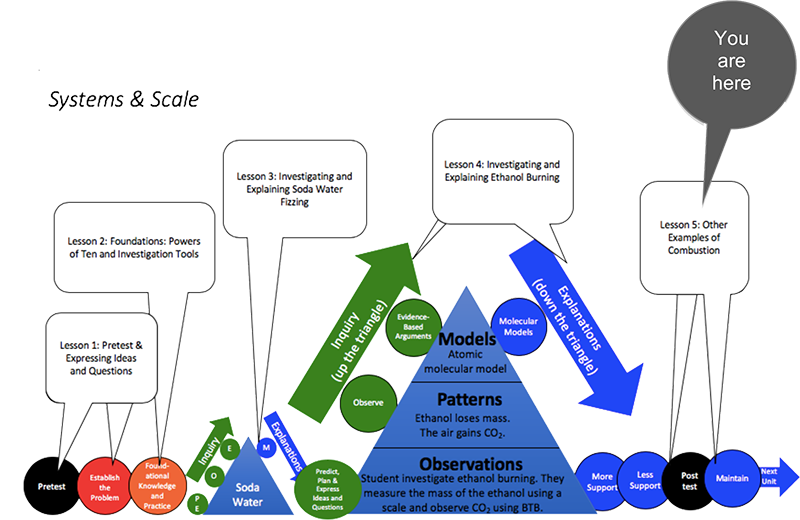Transformations in Matter and Energy Carbon TIME is an NSF-funded partnership led by Michigan State University
Lesson 5 - Other Examples of Combustion
Students learn to distinguish organic from inorganic materials and practice explanations of combustion for other organic materials. They also take the unit posttest.
Guiding Question
What is the difference between materials that burn and materials that don’t burn?
Activities in this Lesson
Note: Activity 5.2 is optional depending on your knowledge of your students and learning goals. If your students can already explain what happens to matter and energy when methane burns at an atomic-molecular scale, you may want to skip these portions of activities. See the Systems and Scale Unit Read Me file for more information to consider when making this choice.
- (Optional) Activity 5.1: Molecular Models for Methane Burning (40 min)
- (Optional) Activity 5.2: Explaining Methane Burning (40 min)
- Activity 5.3: Preparing for Future Units: Organic vs. Inorganic (40 min)
- Activity 5.4: Explaining Other Examples of Combustion (50 min)
- Activity 5.5: Systems and Scale Unit Posttest (40 min)
Unit Map

Target Performances
|
Lesson 5 – Other Examples of Combustion (students as explainers) |
|
|---|---|
|
(Optional) Activity 5.1: Molecular Models for Methane Burning (40 min) |
Students use molecular models to explain how carbon, oxygen, and hydrogen atoms are rearranged into new molecules during the oxidation of methane (the chemical change that happens when methane burns). |
|
(Optional) Activity 5.2: Explaining Methane Burning (40 min) |
Students explain how matter moves and changes and how energy changes when methane burns (connecting macroscopic observations with atomic-molecular models and using the principles of conservation of matter and energy). |
|
Activity 5.3: Preparing for Future Units: Organic vs. Inorganic (40 min) |
Students distinguish between organic and inorganic materials on the basis of both their functions (organic materials include foods, fuels, and the bodies of living things) and the chemical structure of their molecules (organic materials contain high-energy C-C and C-H bonds). |
|
Activity 5.4: Explaining Other Examples of Combustion (50 min) |
Students explain how matter moves and changes and how energy changes when other organic fuels burn, including (a) wood burning in a fireplace, (b) propane burning in a gas grill, and (c) octane burning in an internal combustion engine. |
|
Activity 5.5: Systems and Scale Unit Posttest (40 min) |
Students show their end-of-unit proficiencies for the overall unit goal: Questioning, investigating, and explaining how matter and energy changed during combustion of organic materials. |
NGSS Performance Expectations
Middle School
- Structures and Properties of Matter. MS-PS1-1. Develop models to describe the atomic composition of simple molecules and extended structures.
- Chemical Reactions. MS-PS1-2. Analyze and interpret data on the properties of substances before and after the substances interact to determine if a chemical reaction has occurred.
- Chemical Reactions. MS-PS1-5. Develop and use a model to describe how the total number of atoms does not change in a chemical reaction and thus mass is conserved.
High School
- Chemical Reactions. HS-PS1-4. Develop a model to illustrate that the release or absorption of energy from a chemical reaction system depends upon the changes in total bond energy.
- Chemical Reactions. HS-PS1-7. Use mathematical representations to support the claim that atoms, and therefore mass, are conserved during a chemical reaction.
This lesson of the unit represents the fading portion of the Explanations Phase. This means that students are expected to develop explanations for carbon-transforming processes they studied in this unit in new and novel contexts. The table below shows specific talk and writing goals for the Explanations phase of the unit.
|
Talk and Writing Goals for the Explanations Phase |
Teacher Talk Strategies That Support This Goal |
Curriculum Components That Support This Goal |
|---|---|---|
|
Examine student ideas and correct them when there are problems. It’s ok to give the answers away during this phase! Help students practice using precise language to describe matter and energy. |
Let’s think about what you just said: air molecules. What are air molecules? Are you talking about matter or energy? Remember: atoms can’t be created. So that matter must have come from somewhere. Where did it come from? Let’s look at the molecule poster again… is carbon an atom or a molecule? |
Molecule Poster Three Questions Poster
|
|
Focus on making sure that explanations include multiple scales. |
The investigation gave us evidence for what was happening to matter and energy at a macroscopic sale. But what is happening at an atomic-molecular scale? What is happening to molecules and atoms? How does energy interact with atoms and molecules during chemical change? Why doesn’t the macroscopic investigation tell us the whole story? Let’s revisit our scale poster… what is happening to matter at the molecular scale? |
Molecular Models Molecular Modeling Worksheets Explanations Tool PPT Animation of chemical change Powers of Ten Poster |
|
Encourage students to recall the investigation. |
When did this chemical change happen during our investigation? How do we know that? What is our evidence? What were the macroscopic indicators that this chemical change took place? |
Evidence-Based Arguments Tool Investigation Video |
|
Elicit a range of student explanations. Press for details. Encourage students to examine, compare, and contrast their explanations with others’. |
Who can add to that explanation? What do you mean by _____? Say more. So I think you said _____. Is that right? Who has a different explanation? How are those explanations similar/different? Who can rephrase ________’s explanation? |
Explanations Tool |

 Download Lesson 5 Teacher's Guide PDF
Download Lesson 5 Teacher's Guide PDF